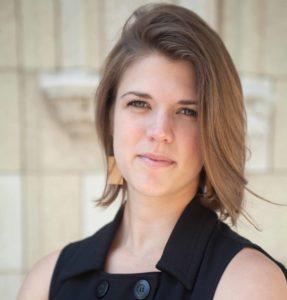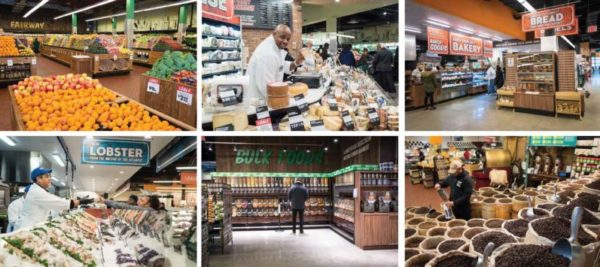The American Institute of Architecture Students (AIAS) is celebrating the 60th anniversary of student excellence in leadership, service, and design. In honor of our 60th year, the AIAS is excited to share 60th: Legacy, an ongoing weekly celebration of and thanks to our alumni sponsored by Professional Publications, Inc (PPI). PPI is a publisher of professional licensing exam materials since 1975 and wants to recognize those who have helped the AIAS achieve 60 years of success.

Name
Deana Moore
Organization
Fairway Market
Title
Vice President of Marketing
Connect
Bio
Deana is currently Vice President of Marketing for Fairway Market, based in Manhattan. Since joining Fairway Group Holdings Corp. she helped to evolve the Fairway Market and Fairway Wine & Spirits brands, which is no small endeavor when working with an iconic brand that’s been rooted in New York City for over 80 years. She has also helped to simplify and advance the business processes; designed, built and opened a brand new Fairway Market in Brooklyn; reconnected with the community, and helped the company survive a Chapter 11 filing. Now two years later, the company is set on a positive path financially, strategically and, most importantly, in the minds of New Yorkers.
Before joining Fairway Market, Deana’s career path was anything but what you would expect from an architecture graduate, however all of these experiences helped prepare and guide her to where she is today. She served as the 52nd national Vice President for the American Institute of Architecture Students and worked at the National Association of Home Builders as their Program Manager for Design. She’s also deeply rooted in the food industry working both for Earth Fare and Whole Foods during and after receiving her architecture degree. (All images courtesy of Fairway Market)
How did your experience with AIAS help you to achieve your goals?
AIAS helped me to believe in myself and helped me realize that my voice matters (even when it’s the minority) and that I should speak up when I feel passionately about something. It started in Charlotte on a chapter level, then grew over the years until I was sitting with the leaders of the architecture profession. I spoke up when I agreed with something and that felt good. Most importantly, I spoke up when I didn’t see eye to eye and had a different perspective which was when I felt like I was making a true difference helping to diversify the voices heard. My years as a student and also my time as a Vice President taught me that a group of passionate individuals who put their minds, talents and energy into something can change just about anything. My time as a legacy member (which now is greater than my years in school and AIAS) have made me realize that you can’t do it alone. The tiny baby steps that we set in motion (almost ten years ago) are now huge leaps forward for the profession. We didn’t do it alone. Rather, we did it by gathering passionate like-minded individuals and giving them a voice. It’s still how I prefer to work today.
What and/or who shaped you into who you are and what you do today?
There is a whole list of people that have helped me, pushed me, lifted me up, and knocked me down. There is no way to list them all, but some were my mentors, some where my friends and some were the people I was trying to help who ended up helping me. They all played a part, no matter how small or large. There are a few things that have been consistent throughout: I’ve always loved looking at numbers and analytics and evaluating their influence on decisions people make. Since I was a teenager, I’ve always had a fascination with food from different cultures and I’ve always loved building things: whether it’s relationships with people and communities or physically building something with my hands. If you really think about it, I’ve always been focused on trying to better understand the human basic needs: food, shelter and community.
How can someone best change the world?
Do what you are passionate about. Focus your energy. Do things right the first time. Don’t waste your time doing things you don’t care about or what you think people want you to care about. That is how the world is going to be a better place, and better yet, it won’t feel like you are working.
How can someone be a better designer?
I’ve been both the designer and the client at this point and from both points of view the advice is the same: 1. Self-edit and admit when you’re wrong. (Just ask my team, I edit my own work over and over.) 2. Throw it all in the trash and start over. (It’s scary, but just do it.) 3. Experience the world around you. (The best ideas come when I’m running, biking, or just out enjoying life.)
What is one tip you would give yourself in your 20s?
Stop stressing out so much! Control the things you can, let go of the things you can’t. You can control how much thought, energy, research you put into what you do. You can’t control how someone else is going to react.
How have you overcome unforeseen challenges through your career?
You have to roll with the punches, trust that everything happens for a reason and when things get rough, just put your head down and work! Right before my tenure as National Vice President of AIAS was coming to a close, the economy crashed (everyone remember 2009?) Architecture firms were laying off up to 50% off their staff. Student that were about to graduate couldn’t find a job anywhere. Firms we’re merging, closing and downsizing all over the country. Up until this point, if you would have asked me what I was going to be doing when I was 30, I would have told you “I’m going to be licensed and starting my own firm.” Then all the job offers I had disappeared and I was living in one of the most expensive cities in the country – D.C. Six months after job searching, I had no choice but to go back to what I knew – health food. At the time I thought it was just a temporary side step, but I worked hard, I loved my work, I spoke up to help make the company better and as a result rapidly moved up the corporate marketing ladder. Fast forward 5 years later and I’m in my favorite city in the world and I couldn’t be happier. I work on retail design one day, our next marketing campaign the next day, analytics the next and working with community leaders the next.
How do you define work-life balance and how is it achievable?
When you’re smiling 50% of your day or more – I’d say you’ve got a pretty good balance. It’s not always going to be perfect but you should enjoy your work and your life. I’ve spent most of my life working long hours. I’ve had a few jobs where I worked 40 hours and if I was happy at work, those late nights and weekend hours didn’t matter. If I was miserable and felt like I wasn’t making a difference, then 40 hours felt like 100-hour work weeks. The best trick I’ve learned is to be self-aware and when I feel like I’m not happy or balanced I step back, take some time to myself and reflect. Most of the time I find that I’m the one putting the pressure on myself and I reprioritize.
What is a decision or action you made in school that influenced your trajectory?
Working for the Daylighting + Energy Lab at UNC Charlotte. It was the perfect balance of being able to use numbers and analytics to influence design, learn a bit about running a business and teach me how to manage up to designers that had been there longer than I or students that were further along in school. Today I’m very involved in day-to-day business and managing up is not only something I do on a daily basis but also expect my team to do for me.
If you, or another AIAS alumni you know, deserves recognition for their contribution to the profession and society at large, please use the link below to nominate them for this honor.











